Type 2 diabetes in the non-pregnant patient
Ob/gyns play a pivotal role in diabetes management due to the condition’s increasing prevalence in women and its potential effects on overall and reproductive health.
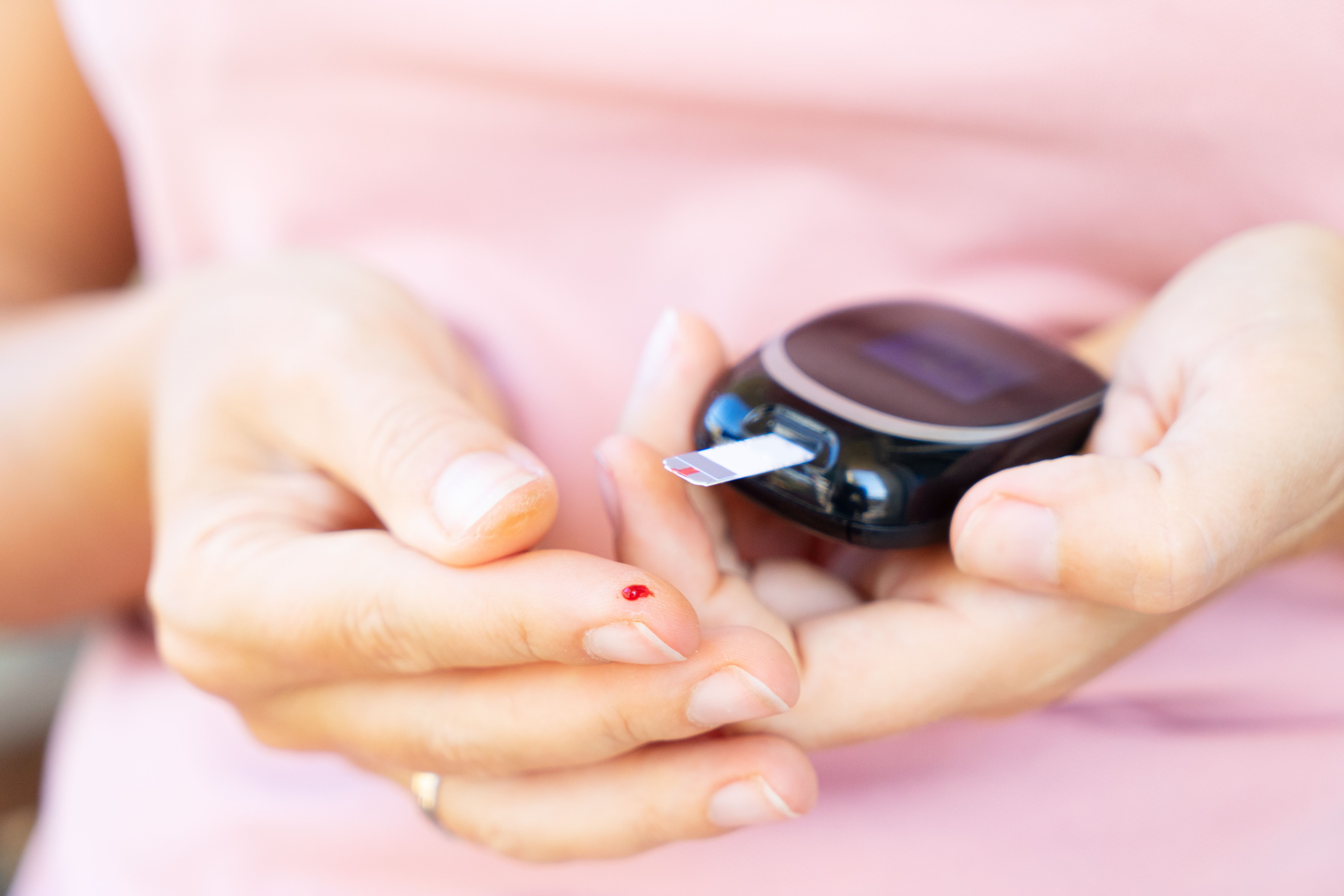
Table 1
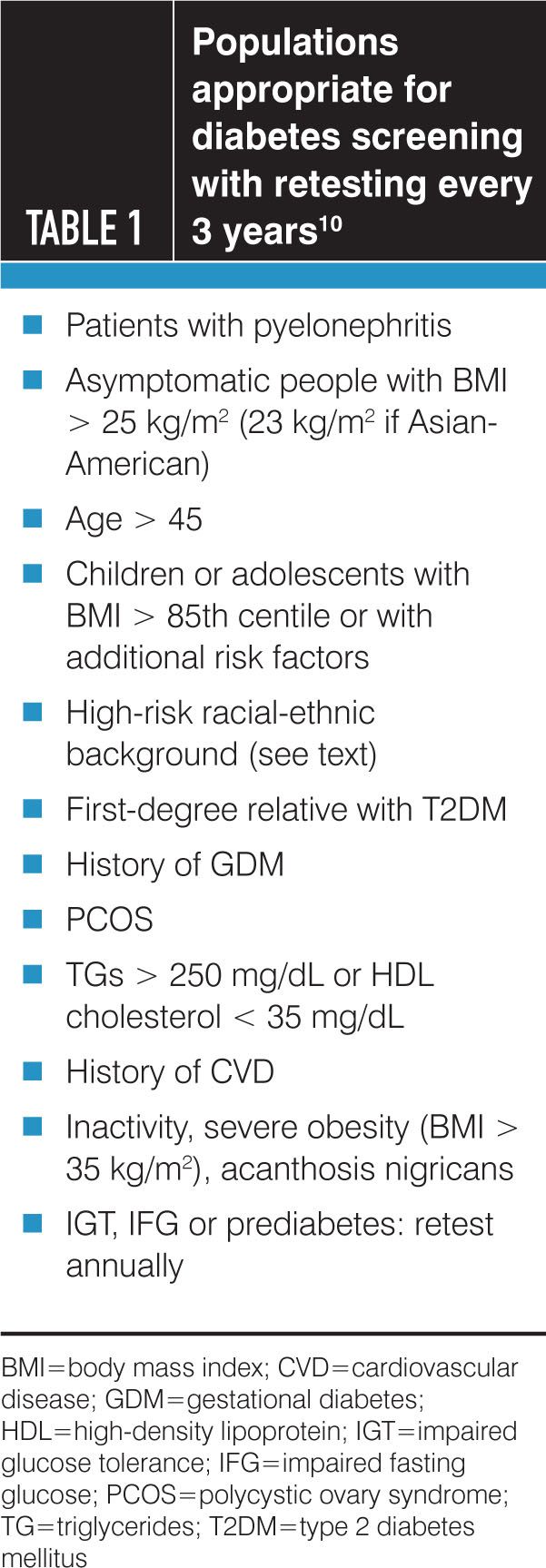
Table 2
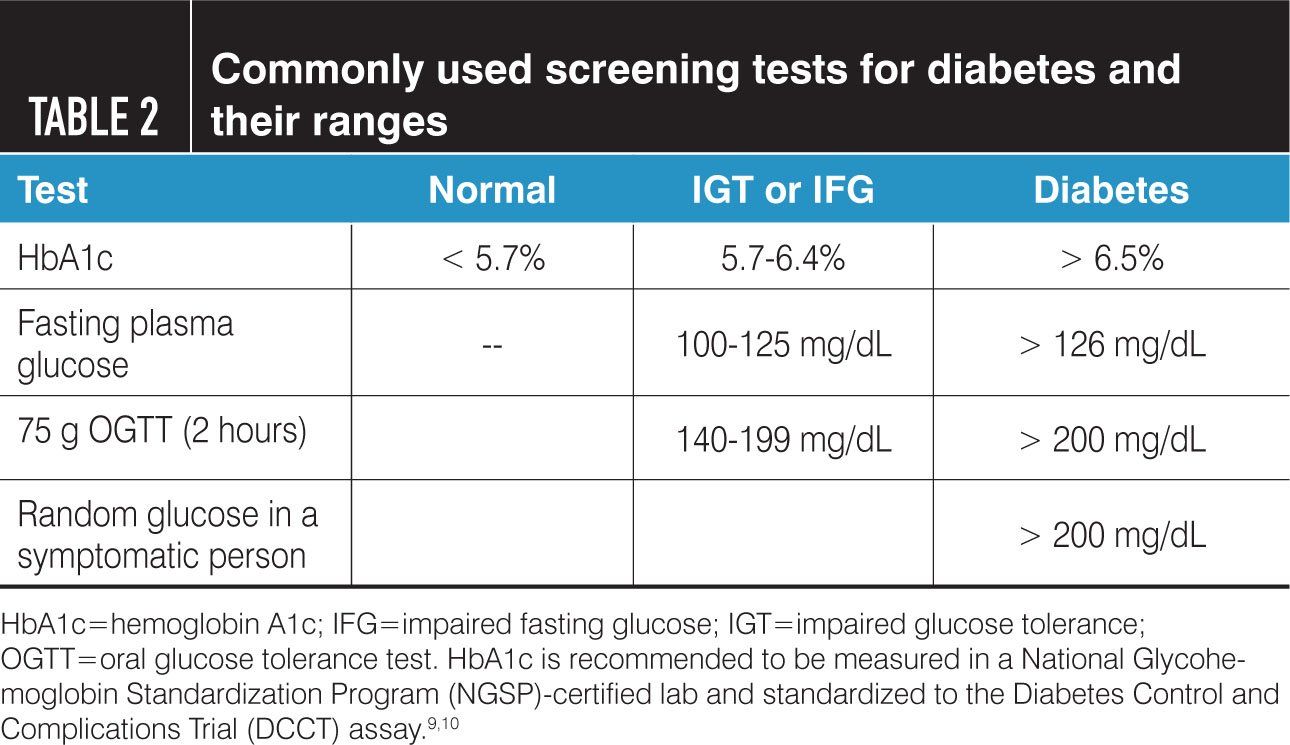
Figure 1
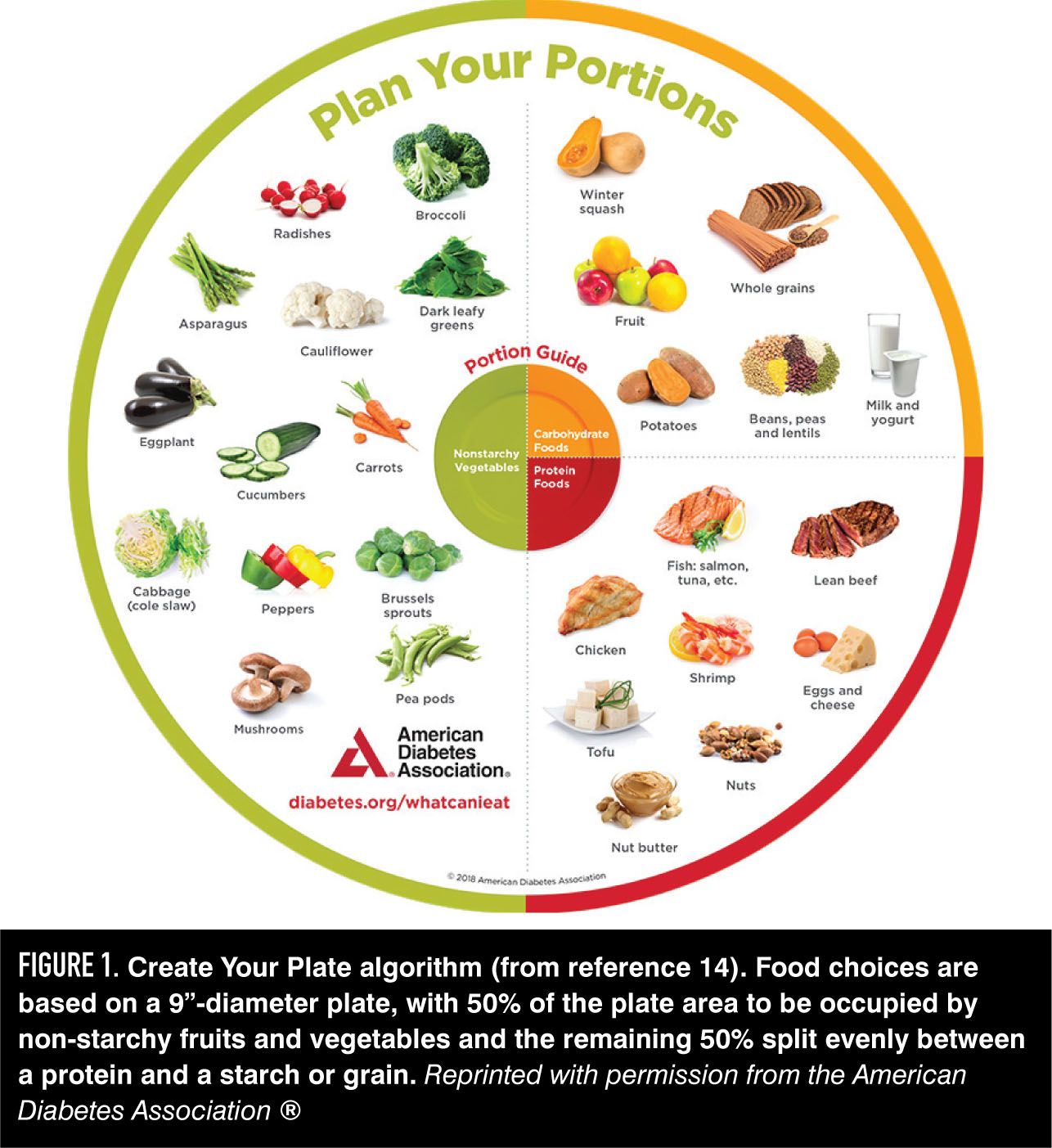
Figure 2
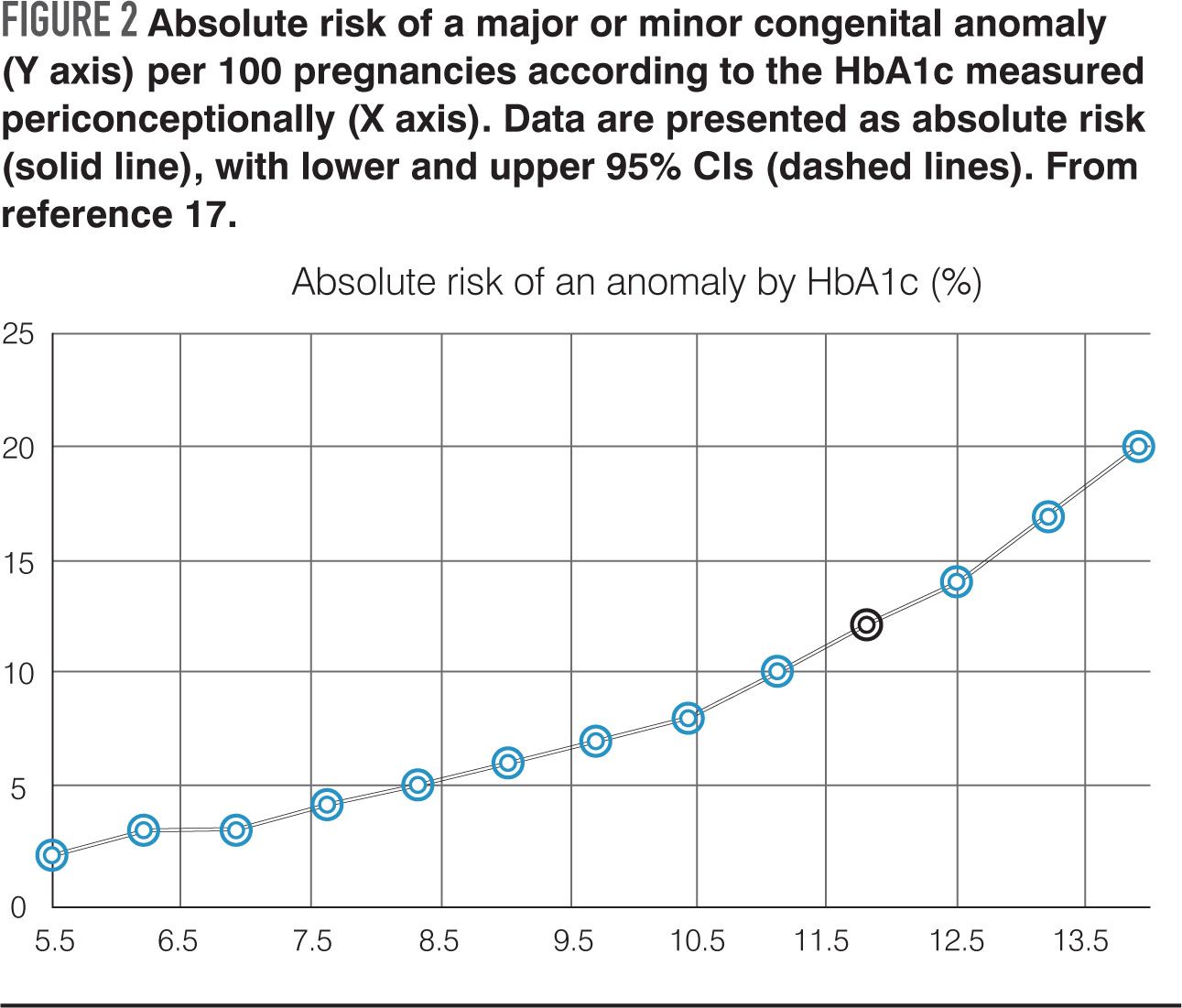
Introduction
Diabetes is a common condition that affects more than 13 million women in the United States.1 It is a chief contributor to morbidity and mortality, with estimated annual costs of $327 billion in 2017.2 Women are disproportionately affected by diabetes, as they have a more complicated clinical course and worse morbidity once they contract the disease. By careful screening, promotion of effective preventive strategies, aggressive case finding, and diligent monitoring of treatment success, there is a great deal that obstetrician-gynecologists can do to help our patients with, or at risk for, diabetes. This review focuses on Type 2 diabetes mellitus (T2DM) because it is far more prevalent than Type 1 disease and accounts for 90% to 95% of all diabetes cases.
Epidemiology
Approximately 9% of the US population aged 18 and older has diabetes.3 African-American, Hispanic, and Native Hawaiian/Pacific Islanders are all twice as likely to develop diabetes as are white women.1,3 About 16% of Native American and Alaskan Native adults have diabetes.3 Diabetes is more common in Asian-American than in white women and develops at a lower body weight compared to other racial groups.
Identification and treatment of diabetes in women is particularly important because it is their biggest single risk factor for heart disease, especially in the premenopausal years. Diabetes is also more likely to lead to blindness in women than in men and is associated with a higher risk for depression than it is for men.4
With the national epidemic of obesity that is afflicting the population, T2DM is being diagnosed more frequently in younger individuals, with racial/ethnic disparities in prevalence that are even more pronounced than they are in adults.5 Girls are also more likely than boys to develop T2DM in childhood or adolescence.5
About 7% of the female population has polycystic ovary syndrome (PCOS)6 and this condition constitutes one of the major risk pools for T2DM in premenopausal women. Fortunately, PCOS is often readily identifiable in the clinical ob/gyn setting. A second major risk group for development of T2DM are women who have had gestational diabetes mellitus (GDM), about 4.6% to 9.2% of pregnant women.7 Their relative risk of subsequent diabetes within 10 years of GDM is over 7-fold compared to women with normoglycemic pregnancies.8
Testing and screening
The US Preventive Services Task Force recommends diabetes screening as part of a cardiovascular risk assessment (Grace B) in asymptomatic adults who are overweight or obese and aged between 40 and 70.9 Individuals with a history of PCOS, GDM, and those of higher-risk racial and ethnic groups (such as African Americans, Native Americans, Alaskan Natives, Hawaiians, Pacific Islanders, Asian Americans and Hispanics) should be considered for screening at younger ages and lower body mass indexes (BMI).9 The American Diabetes Association (ADA) has similar recommendations and most recently recommended screening youth with a BMI higher than the 85th percentile.10Table 1 summarizes current screening recommendations.
Hemoglobin A1c (HbA1c), fasting plasma glucose and oral glucose tolerance testing (OGTT) can all be considered for screening (Table 2).9,10 All positive test results require confirmation before a definitive diagnosis can be made.
Because PCOS is associated with insulin resistance and is typically diagnosed in young women, beta cell reserve may be adequate to maintain normoglycemia under most conditions. Provoking insulin secretion with a glucose challenge is more efficient in eliciting glucose intolerance in the setting of insulin resistance, because chronically elevated insulin levels are more likely to keep fasting glucose normal. In general, younger women are also capable of a rapid, robust insulin response to a meal, and again will be able to maintain nearly normal glucose levels most of the time. Therefore, for younger women with a history of GDM and women with PCOS, an OGTT containing 75 g of glucose should be strongly considered, at least as initial testing, as it will strongly provoke maximal insulin output and elucidate whether true beta cell failure is present. HbA1c and fasting plasma glucose testing are inexpensive and relatively easy for patients, but practicality may favor one testing method over another. Individuals with impaired glucose tolerance and impaired fasting glucose have a very high rate of progression to diabetes (15%-20% will develop T2DM within 10 years) and should be tested annually.
There is strong, Level I evidence that onset of frank T2DM can be delayed or prevented with lifestyle modification and/or metformin treatment in both men and women.11 In a landmark randomized study by the Diabetes Prevention Program, lifestyle modification involved caloric restriction and increased activity, with the goal of 7% loss of body weight and 150 minutes per week of physical activity. Medical management consisted of metformin 850 mg bid. About 50% of the lifestyle group achieved a 7% weight loss and about three-quarters were able to achieve 150 minutes of physical activity per week. Adherence to the metformin arm was 72%. Lifestyle (58% reduction in progression to T2DM) was more effective overall than metformin (31% reduction in progression to T2DM) over the 3-year follow-up period. Both regimens were effective, however, and outcomes with them were more similar in participants aged 25 to 44. Both men and women had similar results, and the study sample included ample numbers of women from which to draw conclusions (67.7% of all 3234 participants were female).
Manifestations and clinical considerations in children
Unlike adults, children and adolescents with diabetes typically develop the disease in the context of multiple social stressors and low socioeconomic status-making lifestyle interventions particularly challenging.5 The course of T2DM in youth is marked by disproportionate prevalence among females, a more rapid decline in beta cell function, and very poor efficacy of traditional treatments that have worked well in adults (metformin and insulin). The surge in childhood obesity contributes in large measure to the increase in this disease in the pediatric population. The pubertal transition, associated with a 50% drop in insulin sensitivity, is also a particularly vulnerable period.5
Optimizing health in the reproductive years
Often, women do not present for a preconception visit. For this reason, it is especially important that all women with known T2DM receive proper counseling during their reproductive years.12,13
Diet and exercise
Guidelines for patients with T2DM are similar to those for patients with GDM. Simple sugars and carbohydrates should be avoided, while integrating a balance of lean proteins and complex carbohydrates should be encouraged. The Centers for Disease Control and Prevention (CDC) and the American Diabetes Association have simplified these recommendations with the “Create your plate” campaign.14 Fifty percent of the plate should have non-starchy vegetables, 25% of the plate should contain grains and starchy vegetables and the remaining 25% protein (Figure 1).14
Exercise is encouraged to optimize health as it improves glycemic control and cardiovascular health. The CDC recommends 30 minutes of brisk walking, 5 times per week or 150 minutes of cardiovascular exercise per week.15
Glycemic control
An increased risk of spontaneous abortion and congenital cardiac anomalies are observed in women with diabetes.16 Evidence shows that tight glycemic control can reduce risk; however, even with good glycemic control, women with T2DM still carry a higher risk than the general population. A curvilinear trend is observed between maternal HbA1c and rate of congenital anomalies. (Figure 2). Thus, it is recommended to encourage women to obtain their best glycemic control possible, with a goal HbA1c < 7%.17 Evidence shows that women with T2DM who receive preconception counseling enter pregnancy with a lower HbA1c and thus decrease their chances of carrying a fetus with congenital anomalies.12 Women with poorly controlled diabetes should be encouraged to use contraception and delay childbearing in order achieve optimal maternal and fetal outcome. Choosing a safe contraception method is of utmost importance.
Smoking cessation
Smoking increases risk of thromboembolic events, cervical cancer and osteoporosis.18 In pregnancy, tobacco use increases risk of miscarriage, stillbirth, preeclampsia, growth restriction, preterm delivery, and placental abnormalities. Poor glycemic control compounds these risks. Women with diabetes who smoke should be educated on these risks and counseled on smoking cessation.19
Weight loss
Encouraging women to achieve an ideal BMI (18.5-24.9) provides both maternal and fetal benefit. Obesity alone has been linked to infertility, spontaneous abortion and poor obstetric outcomes.20 Weight loss helps regulate menses, which can optimize fertility and decrease the risk of endometrial hyperplasia.20
Eye exam
Diabetic retinopathy is a serious complication of T2DM, as it can significantly impair vision and even cause blindness. According to the American Academy of Ophthalmology, patients with T2DM should have an ophthalmic exam at the time diabetes is diagnosed.21 If no diabetic retinopathy is diagnosed, exams should continue annually. If diabetic retinopathy is found, treatment should be performed prior to conception and follow-up scheduled as recommended by the ophthalmologist.21
Supplements, aspirin and medication
Folic acid 400 mcg is the recommended daily amount for reproductive-aged women who are planning to conceive or may conceive. Women with T2DM have a higher risk of carrying a fetus with a neural tube defect than women who do not have T2DM. For this reason, many international societies recommend larger daily doses of folic acid for women with T2DM, but no human evidence supports benefit.22
Patients with T2DM are at a 3-fold increased risk for myocardial infarction; however, aspirin use is not recommended universally for all women with T2DM. A screening tool is available to determine which non-pregnant patients benefit from aspirin use. Most reproductive-age women with T2DM will screen out from aspirin use. However, pregnant women with T2DM should begin 81 mg of aspirin starting at 12 weeks’ gestation for preeclampsia prevention.23 There are insufficient data about the maternal or fetal effects of aspirin prior to 12 weeks’ gestation to justify earlier use.
Diabetic patients with hypertension are likely to be prescribed angiotensin-converting enzyme (ACE) inhibitors and angiotensin II receptor blockers (ARBs) for blood pressure control. Depending on age, statins may also appear on these patients’ medication lists Due to real or potential teratogenic effects of these medications, patients interested in becoming pregnant should be started on an alternative blood pressure regimen, and statins should be discontinued.24 While metformin use was previously controversial, a recent large, international study has shown no increased risk in teratogenicity. For this reason, metformin can be continued in reproductive-age women.25
Contraception in the woman with T2DM
Unfortunately, many patients with T2DM go undiagnosed for years. Poor access to medical care also results in limited access to contraception, and thus, a higher risk of unintended pregnancy. Studies demonstrate that use of hormonal contraception (estrogen and progestin or progestins alone) does not worsen glycemic control, HbA1c levels or accelerate microvascular complications.26 Three remaining issues to consider during contraceptive counseling of diabetic women are safety, efficacy and patient preference. More detail is provided below.
Oral contraceptive pills
Use of oral contraceptive pills (OCPs) for women with diabetes must be individualized to each patient. Women with T2DM are more likely to have comorbidities such as obesity, hypertension, and dyslipidemia, making them less suitable candidates for OCPs.26 A large population study of women with diabetes published in 2017 affirmed this recommendation: a thrombosis rate of 10.1 per 1000 woman-years was observed, far in excess of the expected thrombosis rate in women without diabetes using OCPs.27 However, this study did not differentiate the severity of diabetic disease among women. The WHO Medical eligibility criteria for contraceptive use provide guidelines based on a patient’s comorbidities.28 For women with diabetes as their sole diagnosis, the benefits of using combined OCPs outweigh the risks.26,28 For women with multiple cardiovascular comorbidities (older age, smoker, hypertension, known dyslipidemia) or microvascular disease, OCP use is discouraged.28
Progestin-only pills
Expert opinion considers progestin-only pills (POPs) to be a reasonable alternative for women who are not eligible for combined OCPs, specifically women with microvascular disease.26 WHO recommendations are in agreement – most patients with diabetes are thought to experience more benefit from POP contraception than risk.28 However, in practice, the same large population study showed that diabetic women taking POPs had a similar thrombosis rate to women taking OCPs.27 As above, it is noteworthy that this study did not differentiate the severity of diabetic disease among women, and thus may overstate the thrombotic risk for many women with T2DM.
Intramuscular medroxyprogesterone
Intramuscular (IM) medroxyprogesterone has been associated with an increased risk of thromboembolism in the general population.27 The same finding was demonstrated in women with diabetes.27 The WHO reports that in women with diabetes with complications, IM medroxyprogesterone is likely to cause more risk than benefit.28 Limited evidence exists on newer devices such as the etonorgestrel implant in women with diabetes.27
Intrauterine devices
Although no study has compared the levonorgestrel intrauterine device (IUD) to the copper IUD in the diabetic population, existing data show that all IUDs have a lower rate of thrombosis in the diabetic population than systemic forms of hormonal contraception.27 The WHO reports that even in the highest-risk patients with diabetes, the benefits outweigh the risk.28
Barrier methods and spermicide
No contraindications exist to condoms, diaphragms or spermicide in women with diabetes.28 Poor efficacy of this method should not be underestimated, however, given the importance of contraception in this population of women.
Surgical planning
When planning surgery for patients with T2DM, thought must be given to preoperative, perioperative and postoperative care. Expert opinion concludes that for elective surgery, a patient’s HbA1c should be no higher than 8% to 8.5%.29,30 Patients with T2DM are at higher risk for myocardial infarction and therefore EKG and electrolytes should be part of the preoperative assessment.30 To optimize glycemic control, patients with diabetes should optimally be scheduled for the first case of the day. This ensures that lengthy periods of fasting do not occur, and patients are affected by neither hypoglycemia nor hyperglycemia. They should be properly counseled on which insulin or oral medications to take and at what dose in the 24 hours prior to surgery. Patients with diabetes are more likely to experience renal impairment due to hemorrhage or nephrotoxic medications; therefore, care should be exercised in the postoperative period.31
Conclusions
With T2DM increasing in prevalence and disproportionately affecting women, ob/gyns will continue to play a pivotal role in diagnosis and ongoing management of the disease. Women who are contemplating pregnancy or may become pregnant should be counseled on an opportunistic prognosis. Because pregnancies are likely to be unplanned, counseling will also improve maternal and fetal health. It is important to provide effective contraception that matches the woman’s needs and lifestyle. Maintaining euglycemia throughout the perioperative period is of upmost importance when women with T2DM require surgery.
Disclosures:
The authors report no potential conflicts of interest with regard to this article.
References:
- Prevention, C.f.D.C.a. National Diabetes Statistics Report, 2014. 2014 Available from: https://www.cdc.gov/diabetes/pubs/statsreport14/national-diabetes-report-web.pdf.
- American Diabetes Association. The Cost of Diabetes. Available from: http://www.diabetes.org/advocacy/news-events/cost-of-diabetes.html.
- Centers for Disease Control and Prevention. Summary Health Statistics for US Adults 2013s: 2011. 2012; Available from: https://www.cdc.gov/nchs/data/series/sr_10/sr10_256.pdf.
- Pan A, Lucas M, Sun Q, van Dam RM, et al. Bidirectional association between depression and type 2 diabetes mellitus in women. Arch Intern Med. 2010;170(21): 1884-1891.
- Nadeau KJ, Anderson BJ, Berg EG, et al. Youth-Onset Type 2 Diabetes Consensus Report: Current Status, Challenges, and Priorities. Diabetes Care. 2016;39(9):1635-1642.
- Goodarzi MO, Azziz R. Diagnosis, epidemiology, and genetics of the polycystic ovary syndrome. Best Pract Res Clin Endocrinol Metab. 2006;20(2):193-205.
- DeSisto CL, Kim SY, Sharma AJ. Prevalence estimates of gestational diabetes mellitus in the United States, Pregnancy Risk Assessment Monitoring System (PRAMS), 2007-2010. Prev Chronic Dis. 2014;11:E104.
- Bellamy L, Casas JP, Hingorani AD, Williams D. Type 2 diabetes mellitus after gestational diabetes: a systematic review and meta-analysis. Lancet. 2009;373(9677):1773-1779.
- U.S. Preventive Services Task Force. Final Recommendation Statement: Abnormal Blood Glucoseand Type 2 Diabetes Mellitus: Screening. 2015; Available from: https://www.uspreventiveservicestaskforce.org/Page/Document/RecommendationStatementFinal/screening-for-abnormal-blood-glucose-and-type-2-diabetes.
- Summary of Revisions: Standards of Medical Care in Diabetes-2018. Diabetes Care, 2018;41(Suppl 1):S4-S6.
- Knowler WC, Barrett-Connor E, Fowler SE, et al. Reduction in the incidence of type 2 diabetes with lifestyle intervention or metformin. N Engl J Med. 2002;346(6):393-403.
- Egan AM, Carmody L, Kirwan B, Dunne FP; Atlantic DIP Collaborators. Care of women with diabetes before, during and after pregnancy: time for a new approach? Diabet Med. 2017;34(6):846-850.
- Klein J, Boyle JA, Kirkham R, et al. Preconception care for women with type 2 diabetes mellitus: A mixed-methods study of provider knowledge and practice. Diabetes Res Clin Pract. 2017;129: 105-115.
- American Diabetes Association. Create your plate. Available at http://www.diabetes.org/food-and-fitness/food/planning-meals/create-your-plate/
- Centers for Disease Control and Prevention. Tips for being active with diabetes. Available at https://www.cdc.gov/diabetes/pdfs/managing/Tip_for_Being_Active.pdf
- Greene MF. Spontaneous abortions and major malformations in women with diabetes mellitus. Semin Reprod Endocrinol 1999;17(2):127-136.
- Guerin AR, Nisenbaum, Ray JG. Use of maternal GHb concentration to estimate the risk of congenital anomalies in the offspring of women with prepregnancy diabetes. Diabetes Care. 2007;30(7):1920-1925.
- Committee on Health Care for Underserved Women. Committee opinion number 503: tobacco use and women’s health. Obstet Gynecol. 2011 Sep;118(3):746-750..
- Committee on Underserved Women. Committee opinion no. 721: Smoking cessation during pregnancy. Obsetet Gynecol. 2017 Oct;130(4):e200-e204..
- Talmor A, Dunphy B, Female obesity and infertility. Best Pract Res Clin Obstet Gynaecol. 2015;29(4):498-506.
- AAO PPP Retina/Vitreous Panel, Hoskins Center for Quality Eye Care. Diabetic retinopathy PPP - Updated 2017. Available at https://www.aao.org/preferred-practice-pattern/diabetic-retinopathy-ppp-updated-2017
- Capel I, Corcoy R. What dose of folic acid should be used for pregnant diabetic women? Diabetes Care. 2007;30(7):e63.
- Committee on Obstetrical Practice and Society for Maternal-Fetal-Medicine. ACOG Committee Opinion number 743. Low-Dose Aspirin Use During Pregnancy. Obstet Gynecol 2018; 132: e44-e52.
- Godfrey LM, Erramouspe J, Cleveland KW. Teratogenic risk of statins in pregnancy. Ann Pharmacother. 2012 Oct;46(10):1419-1424.
- Given JE, Loane M, Garne E, et al. Metformin exposure in first trimester of pregnancy and risk of all or specific congenital anomalies: exploratory case-control study. BMJ. 2018;361: k2477.
- Gourdy P. Diabetes and oral contraception. Best Pract Res Clin Endocrinol Metab. 2013 Feb;27(1):67-76.
- O’Brien SH, Koch T, Vesely SK, Schwarz EB. Hormonal contraception and risk of thromboembolism in women with diabetes. Diabetes Care. 2017 Feb;40(2):233-238.
- WHO. Medical Eligibility Criteria for Contraceptive Use - 5th ed. A WHO family planning cornerstone. World Health Organization. 2015, 2015.
- Thompson BM, Stearns JD, Apsey HA, Schlinkert RT, Cook CB, et al. Perioperative management of patients with diabetes and hyperglycemia undergoing elective surgery. Curr Diab Rep. 2016 Jan;16(1):2.
- Membership of the Working Party, Barker P, Creasey PE, et al. Peri-operative management of the surgical patient with diabetes 2015: Association of Anaesthetists of Great Britain and Ireland. Anaesthesia. 2015 Dec;70(12):1427-1440.
- Ead H. Glycemic control and surgery-optimizing outcomes for the patient with diabetes. J Perianesth Nurs. 2009;24(6):384-395.
A Legacy of Excellence: Reflecting on the Final Print Edition of Contemporary OB/GYN
April 25th 2025Marking the end of an era and the beginning of a new chapter, the final print edition of Contemporary OB/GYN celebrates over 50 years of evidence-based guidance and unwavering support for clinicians.
Read More
